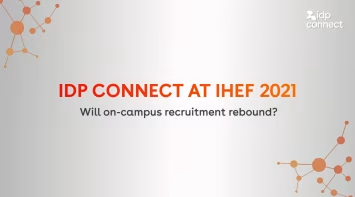The 2020/2021 academic year is now officially underway amidst a chaotic backdrop of a prolonged and disruptive Clearing period, first year students in enforced quarantines at their halls, and questions being asked over financial compensation and whether having Christmas back home will be cancelled.
With so much left to be resolved when it comes to this year’s cohort, it’s no wonder that many institutions have yet to finalise their marketing budget and re-calibrate their recruitment strategies for 2021 recruitment. However, while understandable, a slow start to the recruitment cycle could prove catastrophic for higher education providers, particularly if we fail to learn from the lessons of the past few months.
The UK education sector has suffered from U-turns and a lack of guidance or data during this period of significantly unprecedented challenges. While the year ahead is full of the unpredictable and many more obstacles to overcome, we are now able to provide insight into what REALLY happened over the past few months, as well as what is happening now, and use this data in order to decipher how higher education institutions will need to adapt and make the most of the coming recruitment cycle.
In our latest UK Domestic Trends Webinar: “Dissecting 2021 student research behaviour”, Aaron Porter, Associate Director of Policy & Engagement at IDP Connect, and Kate Wright, Account Director at IDP Connect, broke down 2021 student research behaviour and its changing shape amidst the current pandemic using the latest data and sector knowledge. Here, we’ll share top takeaways from that webinar, focusing on key lessons learnt over the last year and how your institution can adapt to the “new normal” in your domestic recruitment strategies.
Key Takeaways:
In short, the following are the key takeaways our student data shows so far:
2021 lead generation is behind. Coupled with UCAS fairs not happening in Spring, universities need to act now to have ample leads to be nurtured to application for
the UCAS deadline.
Prospective applicants are seeking more supportive content and advice from universities. They want unbiased and informative information. Consider your current communication strategy. These audiences will see through information that is clearly marketed and sold to them.
Prospective applicants are doing more course-level searches in search engines and on our platforms and are veering away from institution-centric content. If your communications currently focus on status pieces (e.g. ranking, TEF etc) then consider the importance of employability, industry links and course USPs.
There has been a drop in interest in the Open Day CTAs. Many universities are seeing high traffic, low engagement or lower levels of sign-ups altogether. Do your virtual open days offer content outside of what students and their parents could get free on your website?
If you’re a top tier institution, your potential pool of students has already started researching you a while ago. If you still need more applications, then an aggressive, top-of-mind approach may be needed now until the UCAS deadline.
If you’re a mid to low tier institution, these students aren’t as engaged
now, and you need to proactively go out to the market to draw them in.
Overview of the Current UK HE Policy Landscape
To look ahead with insight we first need to look back and take stock of where we are today. COVID-19 is still dominating the lives, work and decision making of all staff involved in higher education. This may be somewhat an obvious statement, but it is important to remind ourselves that COVID-19 is impacting on everything from how universities house students to what communications they send them, and of course issues around student wellbeing and safety.
The Coronavirus is impacting upon the work of comms and marketing teams, teaching staff, and university leadership who are still learning and responding to the challenges of re-opening campuses in a way that can provide safe, secure teaching and research. Most Universities in the UK have opted to try and achieve this through a hybrid offering of online and in-person teaching, with the exception of those self-isolating, and we will continue to monitor how the nuances of institutional approaches pan out.
The message from the sector is that students are still getting the same quality of teaching experience, but institutions still face big threats from the prospect of local lockdowns, a rising national R rate, and the increased focus in the media on the adherence of young people to coronavirus measures. The number of students in isolation is rising dramatically, and the situation is evolving rapidly, meaning that the spotlight, and pressure, is certainly on for higher education providers.
These challenges come in the context of the last financial year where the whole HE sector made a surplus of just 3%, so during the COVID-19 crisis Higher Education institutions had little financial room for manoeuvring. Already many universities have lost any profit they had made and are entering this year in a delicate financial situation.
Student recruitment focus this year is about more than success, for many it is about survival.
2020 Cycle and Clearing Data: Insights and Key Learnings for 2021

After the turbulent Clearing period that followed the results days and government U-turns for Scottish Highers and A-levels, 2020 surprised many theorists in that there is an increase in domestic students entering higher education as the chart above, depicting the difference in the number of students between 2019 and 2020 by region placed (Y-axis) and source region (X-axis), shows.
While the drivers for this will have varied by individual student, the final grades were higher than in previous years, and thus unlocked new opportunities for some students. This combined with an acute awareness of the poor labour market prospects and the presumably dire prospect of being locked-down at home for another year may have appeared so bleak that higher education was viewed as the best option for a huge number of students.
Institutions have had to work hard and adapt to meet student obligations for those who met grade criteria only after the revised grades were released and course caps removed, and this has been made possible for many courses. However, some courses like medicine were oversubscribed and this may lead to even stronger demand for these subjects in the coming year.
While we know that there are more placed students in the 2020 cycle than ever before, students are not evenly distributed across the sector, and there are big winners and big losers with variations across institutions who both are up and down in student numbers.
Equally, while the strength in numbers of this year’s intake has relayed some of the fears around having sufficient numbers of students, it is not unreasonable to expect that as the challenges of starting higher education studies away from home, combined with the pressure, stress and limitations of university life under COVID-19, we may see drop-out rates well above normal.
With international recruitment remaining a challenge, 2021 domestic student recruitment will be crucial. The next cohort is already actively searching and following the fate of their peers a year ahead, so how universities handle the experience of this year’s students, in addition to which messages make it to the next cohort, will prove vital in ensuring a healthy 2021 intake.
IDP Clearing 2020 data – lessons to be learnt

The graph above depicts the year-on-year comparison of traffic across our domestic undergraduate websites looking at the week before results day, results day itself, and up to a week and a half after. The data shows that in the lead up to and after results day there was a lot more traffic this year than in 2019.
This suggests students were increasing their use of the sites before results day as a source of trusted information, and that traffic stayed high after results day as students didn’t understand their grades and wanted information as to what options were available for them at that time. The graph also shows a second jump in traffic on the day of the government policy U-turn on grades, which is explored in more detail in the graph below.

The government grades U-turn announcement had a significant impact on student behaviour. On Whatuni, we went from having fewer users compared to the equivalent day in 2019 during the morning, before the announcement, to significantly more after the announcement at 3pm and a higher than normal proportion of “return users” (students who had used our site before). As soon as students understood their grades were going to be upgraded, they returned in large numbers to evaluate their options and the best courses available to them.
The significance of the government U-turn is also evident in the graph below, depicting the shift in grade tariffs searched for before and after the announcement.

Prior to the announcement the top searched grades were BBC, BCC and CCC with a high number of searches also including D grades. This is unsurprising as those students who achieved higher grades were more likely to be accepted onto their first or second choice of university, while those who had been under-graded were left searching for their options. However, after the government announcement, we saw a considerable shift in the grade tariffs searched with ABB the top searched grade combination and A* grades entering the top ten searches. This demonstrates students who now achieved their expected grades but may have initially been rejected from their first-choice university were keen to enter back into the marketplace and find the top courses available to them.
While the final grade results can be considered a positive for this year’s students and teachers, it has implications for 2021. We essentially moved to an unconditional offers system and there are big questions to be asked as to how we proceed for the next recruitment cycle, which we must remember is dealing with a cohort which will have missed school time. Further to this, the support required in the first year of their A-levels will almost certainly factor into these levels of disruption.
It is also important to note that there was a marked increase in traffic to advice and content pages during Clearing, representing a big shift to students seeking out impartial advice and support in understanding a frantic, traumatic and confusing Clearing period. Institutions need to prepare for the 2021 Clearing cycle by asking “how we can make it easier and clearer for students to find the information and support they need?”.
We have also seen, as a consequence of the grades volatility over Clearing 2020, a removal of the student number control, leading to big questions over whether this will remain in place and how it has affected students’ attitudes to entry requirements.
Nurturing Leads in the “New Normal”
There have been big swings in the numbers and what Clearing may look like in terms of budgets and strategies and how able marketing teams have been to plan for 2021. The extended clearing 2020 has meant that for some institutions there has been no time or budget yet to plan for 2021. However, while the reasons for the late start to 2021 recruitment are understandable, their repercussions are already being felt.
For example, the chart below, taken from our demand tracker tool, shows how one of our clients has performed against 5 of its key competitors during Clearing (in green) when it had active campaigns and a strategy and after Clearing (in red) when it had yet to begin marketing and recruitment efforts for 2021.

The blue line in the above graph represents the university while the dark grey represents the competitors. During Clearing, when campaigns were active, the institution was outperforming its competitors, particularly earlier on in Clearing when it had a clear and planned out strategy. However, since the end of Clearing campaigns, with no focus on 2021 recruitment, we can see that the competitor set is outperforming the institution. Without a well-planned marketing and recruitment strategy, your position in the market can lose ground dramatically and rapidly.

However, students for 2021 aren’t waiting. The next cohort is already online and searching for their university options. As you can see from the Pie Chart above, most searches on the Whatuni and Complete University Guide websites are already for 2021 entry. Top of funnel leads are already being lost for institutions who are not present and active in the market. The time to act, is now.
January starts and the postgraduate market – potential opportunities
Our data has also shown an increased focus on the possibility and interest in January 2021 starts. For institutions that already had January intakes, this is more important than ever before. For many institutions who did not have the intakes they wanted, the January intake could provide a second chance. This is not just for the domestic market but also for postgraduate entry, which has been buoyant during September but could be even better for January.
While for undergraduate courses, January start dates may need to be introduced from scratch for some institutions and pose a challenge, on the postgraduate side there is a clear precedent on which to build. Furthermore, traffic on the Postgraduate Search website has consistently outperformed 2019 since April and has increased by over 6% overall year on year, with the focus on January 2021 starts.
There is a huge opportunity for institutions to push the postgraduate intake if they have the capacity, as the trends in traffic and our historical experience indicate the numbers of postgraduate students will increase even further in the next few years as the economic situation and job market decline, leaving more individuals looking to upskill or retrain in order to retain their job or find a new career in a more competitive labour market.
Furthermore, postgraduate courses are arguably easier to adapt to COVID-19 restrictions whilst retaining their value and appeal. For example, online course provision is something that is now necessary, to some extent, for all levels of study and institutions must shift from using online teaching as an “add-on” to ordinary teaching to having value as a more integral part of studies.
While for undergraduate studies this is a more challenging adjustment, online teaching has been more common in postgraduate courses and so is more natural and less of a hard-sell to prospective students. Quality online teaching support for postgraduate students, who do a larger quantity of independent work anyway, is less of a deterrent to starting a course. As a result, increasing numbers on postgraduate courses can relieve pressure on student numbers while social distancing.
How will the 2021 cohort be different?
Looking ahead to next year’s exams, it is important to consider how everything from this year’s cohort’s education to their physical exams could be very different, and to plan for it. The official line from the Government is that A-levels and Scottish Highers will go ahead as normal, but after this year it is essential that we consider what contingencies and preparation is needed for different scenarios.
The government has put a lot of their credibility on schools staying open, so will probably be one of the last things to close, however this could still be a possibility. Equally, even if exams do go ahead as expected, the disruption to the learning experience that this year’s cohort has already suffered and will likely cumulatively acquire over the next 12 months, means that exam boards will need to take additional considerations into account. After the disruption to students’ studies and their varied impact on the distribution of grade, grade boundaries cannot be drawn in the same clear, algorithm-based way they have been in the past. How universities make offers needs to be reconsidered and ongoing attention needs to be paid to the development of this issue.
It is also important to consider that the current year 13s, who were year 12s under lockdown, have had a unique educational experience which will impact on both their grades and their approach to university and university research. We can see the difference in this year’s cohort even in terms of the tariff points of their course searches in the graph below.

Perhaps surprisingly, grade tariffs for next year are being searched higher than the ones we experience this year. What this may reflect is that lower grade students have yet to consider their higher education options. They are not necessarily even considering higher education at all, whereas students with higher predicted grades still see it as a viable and important next step for them. This has implications for marketing and how all students are reached. To get the C and D grade student more proactive marketing will be needed that is imaginative and goes beyond course and institution profiles on the site.
Marketing during COVID-19: What our data indicates and how we can help
How to best use budgets
The question of how to use marketing budgets most effectively is always key but has been made even more prevalent issue this year as budgets have often become more constricted and the mindset of prospective students has changed.
2020 was very hard and unpredictable with agility and quick decisions forced upon institutions. We can expect many more curveballs to come in 2021, however, we have new tools at our disposal to overcome them. We now have more data and the ability to track these shifts in student attitude and behaviour, enabling accurate predictions, quick reactions and the shifting of messaging according to student interests.
This monitoring of student behaviour and prioritise has already demonstrated important shifts in their searches. While year-on-year traffic on Whatuni has remained stable, with only a slight increase, what we have seen is a decline of over 10% in the number of users looking at profile content on our sites. What this means is that there is less interest from prospective students in institution-level information on features such as accommodation, facilities, city life, university status etc. Applicants are currently less interested in these aspects of their prospective higher education experience, which poses a challenge for messaging that has normally focused on institutions status and student lifestyle.
So, what are students looking at? Course page views are up just over 2%, which does not represent a massive shift but given the traffic (over 16 million) is still significant and indicates that an increased focus on course details will be important this year.
Similarly, one of the most prevalent changes is entrances straight to course search pages, where users have searched for courses in a search engine, which are up 14%. What this means for conversion tactics is that course and subject level campaigns are increasingly important. For institutions, this shows that paid search is important but it is also crucial to adapt strategies from advertising at an institutions level to at a course level.
Managing the duality of “where to study” and “what to study” has always been an issue for marketing teams, however this year “what to study” is stronger. This has been shown with the move to online open days, where this is particularly prevalent.
Becoming a trusted source
The other side with the biggest increase in traffic is advice pages, as shown on the graph below, which has seen a significant increase not only in terms of page views, which are up nearly 8% year- on-year, but also in terms of the time spent on each page which has increased by over 30%.

Students are confused and need advice from sources they trust so this year poses an excellent opportunity to build your relationship with prospective students by being a trusted source of information that intends to support them, not sell to them.
What advice are students searching for?
The question of safety is huge for students and needs to be put front of mind for prospective students throughout the 2021 recruitment cycle.
Given the challenges of the last couple of weeks, we must also consider that it’s reasonable to expect the official university message may not be trusted as much, at least initially and while universities demonstrate their ability to care for students during COIVID-19 outbreaks. An immediate solution to any mistrust of the official university messaging is to use authentic messages from real students, ranging from student reviews to messaging from the student union about how your institution is coping and supporting will be highly valuable.
Furthermore, while there have already been difficulties as a result of local lockdowns, many institutions are taking sensible steps to look after their students in services, which are being recognised by their students. This is a great opportunity to make yourself stand out by delivering excellent services and taking steps to care for the student population, they will get the word out and peer to peer messaging remains one of the most powerful marketing tools at your disposal.
The Opportunities in Email Conversions
With less physical interaction and the new context of marketing, understanding what students are looking at and their behaviour on our sites shed some light on what institutions can actively do to effectively market this year.
There are 4 CTAs on the Whatuni site, “Visit Website”, “Book Event” (open day), “Get Prospectus” and “Request Information”. In most cases, the former 2 are web clicks, while the latter 2 result in email enquiries.
Looking at the behaviour changes in 18 universities we found that this year is seeing some important shifts between the clickable and email CTA’s.
Firstly, ‘Book Event’ call to action conversion is down. Universities are having to do virtual open days now and it seems that students and their influencers are not seeing the value of virtual open days. In order to address this, institutions are going to need to show that these virtual events are unique and invaluable perhaps by providing example online lectures and tutorials that cannot be found elsewhere.
Comparatively, the conversions for the emails CTAs are up. We have seen a dramatic increase in the ‘Request info’ conversion which lies behind a gated platform, necessitating the entering of email addresses and personal information. This shows that students’ willingness to share information in order to open a dialogue is much higher this year. Students want information and support that is personalised to them and are keen to speak to someone about their unique position. This suggests a development of the trend we saw during Clearing where students were more likely to call in order to speak to someone directly about their situation.
Therefore, if email is a growing medium for marketing, the question now is how are universities using email leads to enter a conversation with students? In accordance with GDPR, when a student emails you as an institution, you can only respond to the one email and its content that you receive from each individual student. However, on our sites we have a new function where we can add the “opt-in” to further communications on our enquiry forms. This means the university can contact the student about any information, not just their one enquiry, opening a highly valuable avenue of communication, marketing and building a personalised relationship with a new lead.
Having this incorporated in Whatuni, which is known as a trusted and unbiased source of information, increases the likelihood that students will opt-in and we have seen the email opt-in rates climb from 10% to 36% when moved from the institution’s platform to our site. Students are more willing to hear from universities via us, which allows universities to really begin the dialogue and provide the course led and personalised information that resonates with the students.
Summary:
The 2021 recruitment cycle will hold new challenges, but already we are seeing new opportunities in how we reach and communicate with an active, astute and engages student base. We will continue to provide insight into how student behaviour is changing and what this means in terms of how best to engage with domestic students throughout the funnel. Should you wish to discuss any of the topics covered here today, inquire around trends in subject demand, or delve into our real-time IQ data and marketing services, please reach out to us here.
Should you wish to watch the webinar in full, a recording can be found here:
Watch Webinar RecordingDownload the presentation materials here:
Download Post-Webinar PackYou might like...

Peer-to-Peer: Why Student Ambassadors are Key Connections Throughout the Recruitment Funnel
Providing the right information and support for students

Interview with Hotcourses Vietnam’s Senior Country Marketing Executive
Combining strategic and creative thinking to positively impact thousands of lives

Connecting Prospective Students with Experienced Students: Why Peer-to-Peer Engagement is Valuable and Effective
Powerful influencers, advocates for your brand – student ambassadors are key for recruitment.



